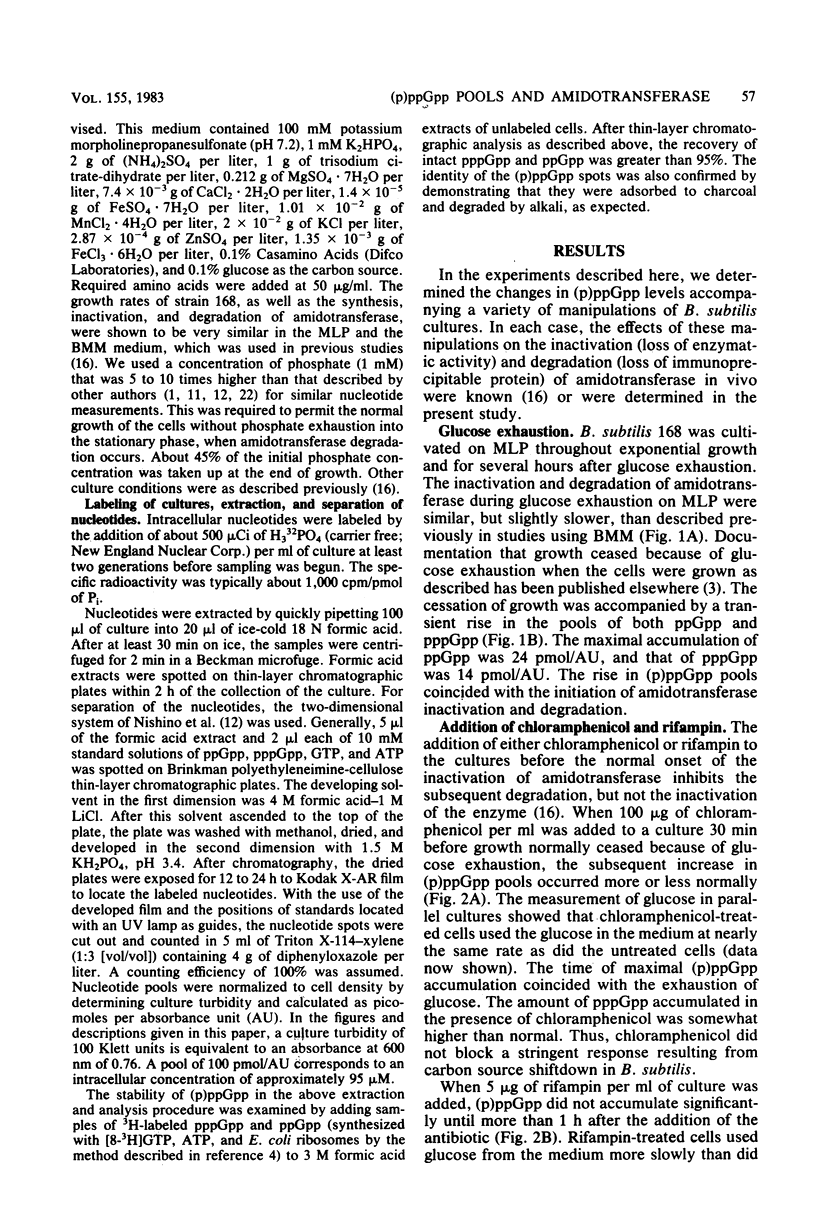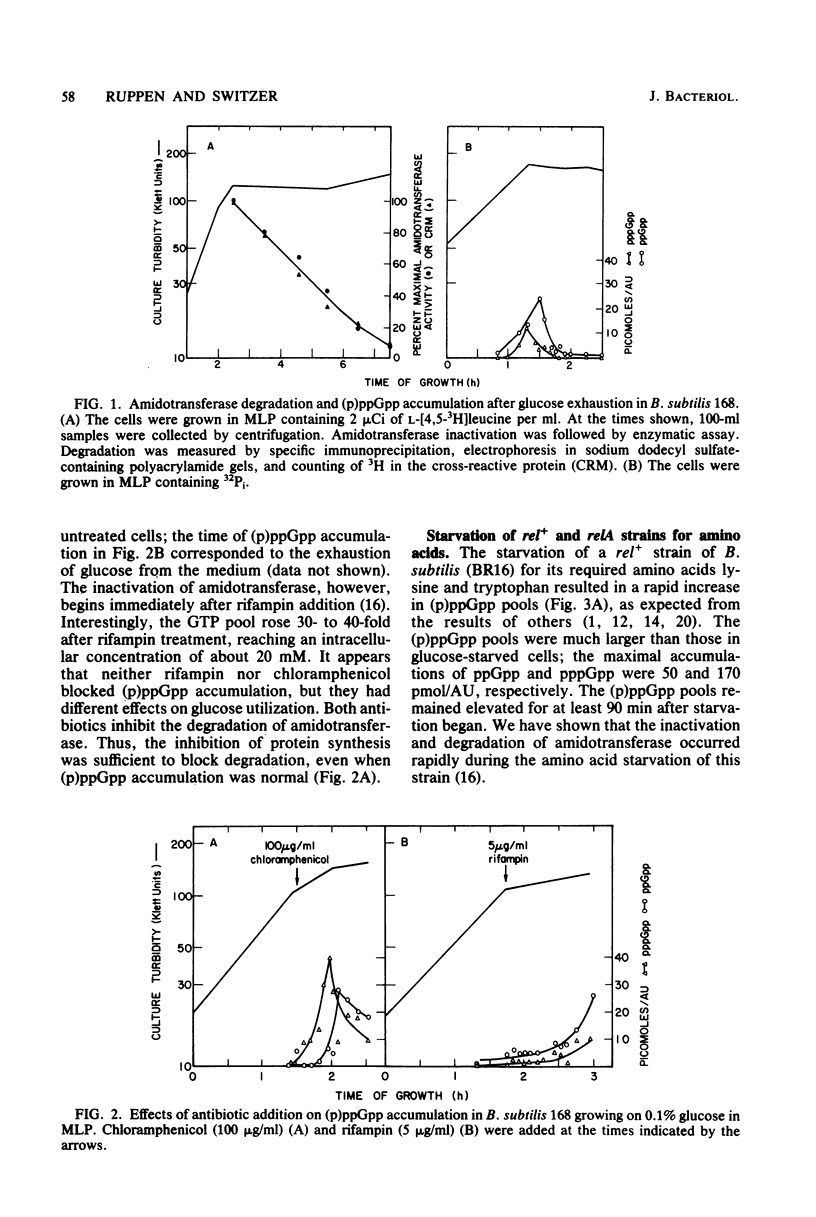Abstract
Glutamine phosphoribosylpyrophosphate amidotransferase, the first enzyme of purine biosynthesis, has previously been shown to be rapidly inactivated and degraded in Bacillus subtilis cells at the end of growth. The loss of enzyme activity appears to involve the oxidation of an iron-sulfur cluster in the enzyme. The degradation of the inactive enzyme involves some elements of the stringent response because it is inhibited in relA and relC mutants. Intracellular pools of guanosine tetra- and pentaphosphate were measured by an improved extraction procedure in cells that had been manipulated in various ways to induce or inhibit amidotransferase degradation. The results are consistent with the hypothesis that one or both of these nucleotides stimulates the synthesis of a protein involved in degradation. An elevated level of these nucleotides was not required for the continued degradation of amidotransferase once it had begun.
Full text
PDF







Selected References
These references are in PubMed. This may not be the complete list of references from this article.
- Bernlohr D. A., Switzer R. L. Reaction of Bacillus subtilis glutamine phosphoribosylpyrophosphate amidotransferase with oxygen: chemistry and regulation by ligands. Biochemistry. 1981 Sep 29;20(20):5675–5681. doi: 10.1021/bi00523a006. [DOI] [PubMed] [Google Scholar]
- Bernlohr D. A., Switzer R. L. Regulation of Bacillus subtilis glutamine phosphoribosylpyrophosphate amidotransferase inactivation in vivo. J Bacteriol. 1983 Feb;153(2):937–949. doi: 10.1128/jb.153.2.937-949.1983. [DOI] [PMC free article] [PubMed] [Google Scholar]
- Cashel M. Preparation of guanosine tetraphosphate (ppGpp) and guanosine pentaphosphate (pppGpp) from Escherichia coli ribosomes. Anal Biochem. 1974 Jan;57(1):100–107. doi: 10.1016/0003-2697(74)90056-6. [DOI] [PubMed] [Google Scholar]
- Cashel M. Regulation of bacterial ppGpp and pppGpp. Annu Rev Microbiol. 1975;29:301–318. doi: 10.1146/annurev.mi.29.100175.001505. [DOI] [PubMed] [Google Scholar]
- Fehr S., Richter D. Stringent response of Bacillus stearothermophilus: evidence for the existence of two distinct guanosine 3',5'-polyphosphate synthetases. J Bacteriol. 1981 Jan;145(1):68–73. doi: 10.1128/jb.145.1.68-73.1981. [DOI] [PMC free article] [PubMed] [Google Scholar]
- Hughes J., Mellows G. Inhibition of isoleucyl-transfer ribonucleic acid synthetase in Escherichia coli by pseudomonic acid. Biochem J. 1978 Oct 15;176(1):305–318. doi: 10.1042/bj1760305. [DOI] [PMC free article] [PubMed] [Google Scholar]
- Ikehara K., Ando H., Takada Y., Sugae K. Presence of guanosine 5'-diphosphate 3'-diphosphate in Bacillus subtilis vegetative cells. J Biochem. 1981 Feb;89(2):511–516. doi: 10.1093/oxfordjournals.jbchem.a133226. [DOI] [PubMed] [Google Scholar]
- Ikehara K., Maeda K., Makino S., Sugae K. Disappearance of guanosine 5'-diphosphate 3'-diphosphate in Bacillus subtilis vegetative cells upon carbon source deprivation. J Biochem. 1981 Feb;89(2):517–521. doi: 10.1093/oxfordjournals.jbchem.a133227. [DOI] [PubMed] [Google Scholar]
- Lagosky P. A., Chang F. N. The extraction of guanosine 5'-diphosphate, 3'-diphosphate (ppGpp) from Escherichia coli using low pH reagents: a reevaluation. Biochem Biophys Res Commun. 1978 Oct 30;84(4):1016–1024. doi: 10.1016/0006-291x(78)91685-6. [DOI] [PubMed] [Google Scholar]
- Nishino T., Gallant J., Shalit P., Palmer L., Wehr T. Regulatory nucleotides involved in the Rel function of Bacillus subtilis. J Bacteriol. 1979 Nov;140(2):671–679. doi: 10.1128/jb.140.2.671-679.1979. [DOI] [PMC free article] [PubMed] [Google Scholar]
- Price V. L., Brown L. R. Transcriptional inhibition and production of guanosine polyphosphates in Bacillus subtilis. J Bacteriol. 1981 Sep;147(3):752–756. doi: 10.1128/jb.147.3.752-756.1981. [DOI] [PMC free article] [PubMed] [Google Scholar]
- Rhaese H. J., Dichtelmüller H., Grade R. Studies on the control of development. Accumulation of guanosine tetraphosphate and pentaphosphate in response to inhibition of protein synthesis in Bacillus subtilis. Eur J Biochem. 1975 Aug 15;56(2):385–392. doi: 10.1111/j.1432-1033.1975.tb02244.x. [DOI] [PubMed] [Google Scholar]
- Rhaese H. J., Grade R., Dichtelmüller H. Studies on the control of development. Correlation of initiucleotides in Bacillus subtilis. Eur J Biochem. 1976 Apr 15;64(1):205–213. doi: 10.1111/j.1432-1033.1976.tb10289.x. [DOI] [PubMed] [Google Scholar]
- Ruppen M. E., Switzer R. L. Degradation of Bacillus subtilis glutamine phosphoribosylpyrophosphate amidotransferase in vivo. J Biol Chem. 1983 Mar 10;258(5):2843–2851. [PubMed] [Google Scholar]
- Smith I., Paress P., Cabane K., Dubnau E. Genetics and physiology of the rel system of Bacillus subtilis. Mol Gen Genet. 1980;178(2):271–279. doi: 10.1007/BF00270472. [DOI] [PubMed] [Google Scholar]
- Smith I., Paress P., Pestka S. Thiostrepton-resistant mutants exhibit relaxed synthesis of RNA. Proc Natl Acad Sci U S A. 1978 Dec;75(12):5993–5997. doi: 10.1073/pnas.75.12.5993. [DOI] [PMC free article] [PubMed] [Google Scholar]
- St John A. C., Conklin K., Rosenthal E., Goldberg A. L. Further evidence for the involvement of charged tRNA and guanosine tetraphosphate in the control of protein degradation in Escherichia coli. J Biol Chem. 1978 Jun 10;253(11):3945–3951. [PubMed] [Google Scholar]
- Swanton M., Edlin G. Isolation and characterization of an RNA relaxed mutant of B. subtilis. Biochem Biophys Res Commun. 1972 Jan 31;46(2):583–588. doi: 10.1016/s0006-291x(72)80179-7. [DOI] [PubMed] [Google Scholar]
- Voellmy R., Goldberg A. L. Guanosine-5'-diphosphate-3'-diphosphate (ppGpp) and the regulation of protein breakdown in Escherichia coli. J Biol Chem. 1980 Feb 10;255(3):1008–1014. [PubMed] [Google Scholar]


